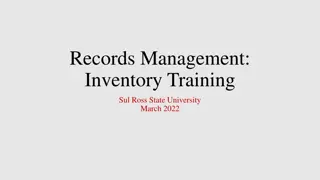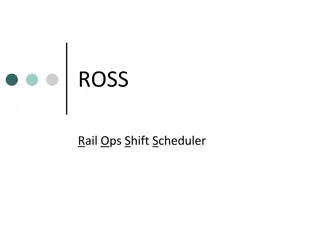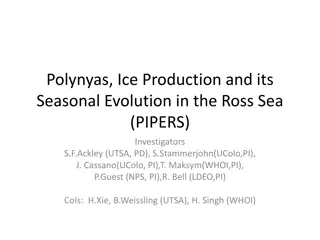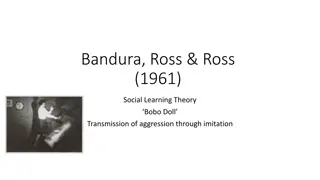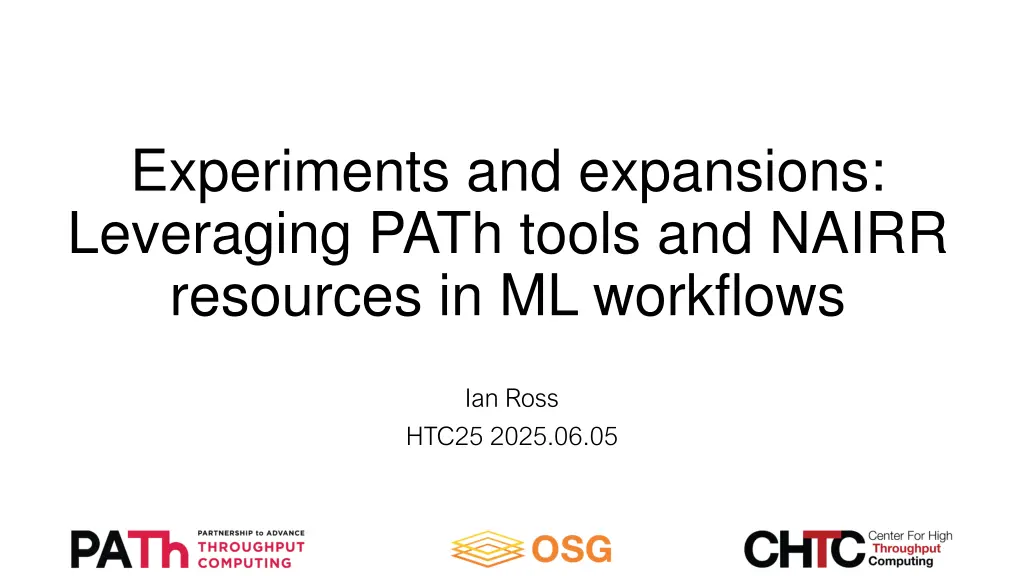
Leveraging PATh Tools for ML Experiments and Expansions
Explore the use of PATh tools and NAIRR resources in ML workflows to test the impact of training and inference on distributed, heterogeneous capacity. Utilize HTCondor annexes to run training jobs in diverse sites, compare distributed models to single-node versions, and access NAIRR compute efficiently. Dive into a holistic overview of the National Artificial Intelligence Research Resource (NAIRR) infrastructure and its role in advancing responsible AI research and innovation.
Download Presentation

Please find below an Image/Link to download the presentation.
The content on the website is provided AS IS for your information and personal use only. It may not be sold, licensed, or shared on other websites without obtaining consent from the author. If you encounter any issues during the download, it is possible that the publisher has removed the file from their server.
You are allowed to download the files provided on this website for personal or commercial use, subject to the condition that they are used lawfully. All files are the property of their respective owners.
The content on the website is provided AS IS for your information and personal use only. It may not be sold, licensed, or shared on other websites without obtaining consent from the author.
E N D
Presentation Transcript
Experiments and expansions: Leveraging PATh tools and NAIRR resources in ML workflows Ian Ross HTC25 2025.06.05
PATh ML supplement ~1 year supplement to PATh to profile the effects of training and inference on distributed, heterogeneous capacity Use htcondor annexes to run training jobs into National AI Research Resource (NAIRR) Intentionally shuffle training runs between sites at epoch boundaries to test resilience and impact of heterogeneity Compare models trained in distributed fashion to baseline (single-node trained) versions Exercise our technologies to see how they operate in a heterogeneous AI setting while establishing single-point access to NAIRR compute Microscoft Copilot prompt: A cartoon image of a pelican and a condor holding hands over a landscape made of computer chips at sunset 2
NAIRR in a nutshell The National Artificial Intelligence Research Resource (NAIRR) is a concept for a shared national research infrastructure to bridge this gap by connecting U.S. researchers to responsible and trustworthy Artificial Intelligence (AI) resources, as well as the needed computational, data, software, training, and educational resources to advance research, discovery, and innovation. From nairrpilot.org We applied for, and received, allocations at 6 computational resources for this experiment. Expanse, Bridges-2, Anvil, Delta, Jestream2, AWS 3
PATh supplement, workflow and science case Objectives: 1. Characterize the impact of training models and ensembles across heterogeneous resources 2. Advance PATh Access Point capabilities to reduce the barrier of entry and support ML workloads in distributed and heterogeneous environments like NAIRR Eval Eval Epoch 1 Training (Resource A) Eval Epoch 2 Eval Training (Resource B) Eval Epoch 3 Eval Training (Resource C) Training (Resource D) Epoch 4 Eval Eval Training (Resource E) Eval Eval Epoch 5 Domain benchmark from Gitter lab: Training a protein language model for use in protein engineering: Comparison of n model training path permutations MQHTYPAQLRRFGQA MQHTYLAQLMRWGTH MQHTYPAQLMRTTTA MQHTPPAQLMQFGTA MQHTSPAFLMRFGTA MAHTYPAQLMRAGTA (~20h/epoch on A100) (~1min/epoch) Model capable of more accurate predictions than training on the limited experimental data directly. Finetune using ~100 experimental measurements of protein sequence mutations Pretrain protein LLM using ~10M biophysical simulations ~40GB on disk Pretrained Model 4
PATh supplement, status Training process working on Delta, Expanse, Bridges-2, OSPool, CHTC Took longer than anticipated to iron out wrinkles to get consistent epochs In parallel adapting a DAG generator to ease management and organization while further probing our stack Plenty more to come on this 5
Annexes, NAIRR resources, and lessons learned Overall, things worked fairly well Documentation, annex creation, htcondor-cli, all good with a few odd snares (to come) Bit of a pain to manage and organize across 6 different sites (plus CHTC and OSPool), each with their own documentation and quirks and policies.. As Doug said yesterday, Every facility is a snowflake Storing apptainer image and data in OSDF great success! 6
Annexes, NAIRR resources, and lessons learned Long epochs make for painful mistakes and awful iterative development Hard to understand failures and idle jobs. Would love annex create -mem 128GB instead of annex create mem_mb 131072to be consistent with RequestMemory=128GB +JobDurationCategory = "Medium" default on all jobs on ap40 With epochs taking 18-25 hours, this one was a big what was happening Organization and management is a pain (and we want to be introspective), so big headache before I realized 7
Overview of MLDAG Objective: Adapt Thinh Nguyen s work from last summer to generate DAGs for the heterogeneous resource experiment Shish-kebab DAGs, with NAIRR resource shuffling via annex Less about a production Less about a production- -level tool and more about recognizing and more about recognizing shortcomings, pain points, and shortcomings, pain points, and capabilities in current system. capabilities in current system. And also retaining my sanity Sidequest: Understand needs and patterns in common experiment workflows like hyperparameter sweeps level tool 8
Overview of MLDAG An experiment consists of x training runs , each of which consists of y epochs of training, handled within n training jobs (nodes) within the training run The training runs likely differ based in user-specified ways (targeted resources, hyperparameters, ) Each training job has a common submit definition with differences captured in VARS E.g. targets a different NAIRR resource, but this is unlikely to be a common pattern so I ll ignore it (although the utility supports resource specific configuration) Each node can also be associated with an evaluation job to check in with the training process 9
Experiment configuration and DAG generation Experiment.yaml file to capture: Name of the experiment Template for submit description Variables that either define training run behavior (total number of epochs, epochs per job) or or define possible values variables can take in order to define the shape of the experiment. DAG generation script will: Sets (and fans out) the variables and combinatorics Create Training Runs for each combination of variables Define job nodes with appropriate VARS Optional special sauce and useful (to me) defaults Site-specific resources requests with site targeting and shuffles Random seed and unique ID per training runs Handles for service node definitions, PRE- and POST-scripts 10
name: "Global Pretraining" submit_template: | universe = container container_image = osdf:///ospool/ap40/data/ian.ross/metl_global.sif request_disk = {resource.disk} request_memory = {resource.mem_mb} request_cpus = {resource.cpus} request_gpus = {resource.gpus} gpus_minimum_memory = {resource.gpu_memory} gpus_minimum_capability = 7.5 executable = /bin/python transfer_executable = false arguments = pretrain.py --learning_rate=$(alpha) queue vars: epochs: value: 30 type: value description: "Number of epochs to train for" epochs_per_job: value: 5 type: value description: "Number of epochs to train in each job" alpha: start: 0 stop: 10 step: 1 type: range description: "learning rate example" 11
name: "Global Pretraining" submit_template: | universe = container container_image = osdf:///ospool/ap40/data/ian.ross/metl_global.sif These get filled in by specific values for each NAIRR resource that get passed in during the DAG generation, if any. Defaults can be set for more general usage. request_disk = {resource.disk} request_memory = {resource.mem_mb} request_cpus = {resource.cpus} request_gpus = {resource.gpus} gpus_minimum_memory = {resource.gpu_memory} gpus_minimum_capability = 7.5 executable = /bin/python transfer_executable = false arguments = pretrain.py --learning_rate=$(alpha) queue vars: epochs: value: 30 type: value description: "Number of epochs to train for" epochs_per_job: value: 5 type: value description: "Number of epochs to train in each job" alpha: start: 0 stop: 10 step: 1 type: range description: "learning rate example" 12
name: "Global Pretraining" submit_template: | universe = container container_image = osdf:///ospool/ap40/data/ian.ross/metl_global.sif These get filled in by specific values for each NAIRR resource that get passed in during the DAG generation, if any. Defaults can be set for more general usage. request_disk = {resource.disk} request_memory = {resource.mem_mb} request_cpus = {resource.cpus} request_gpus = {resource.gpus} gpus_minimum_memory = {resource.gpu_memory} gpus_minimum_capability = 7.5 Just standard VAR usage, but must match definition in vars field executable = /bin/python transfer_executable = false arguments = pretrain.py --learning_rate=$(alpha) queue vars: epochs: value: 30 type: value description: "Number of epochs to train for" epochs_per_job: value: 5 type: value description: "Number of epochs to train in each job" alpha: start: 0 stop: 10 step: 1 type: range description: "learning rate example" 13
name: "Global Pretraining" submit_template: | universe = container container_image = osdf:///ospool/ap40/data/ian.ross/metl_global.sif These get filled in by specific values for each NAIRR resource that get passed in during the DAG generation, if any. Defaults can be set for more general usage. request_disk = {resource.disk} request_memory = {resource.mem_mb} request_cpus = {resource.cpus} request_gpus = {resource.gpus} gpus_minimum_memory = {resource.gpu_memory} gpus_minimum_capability = 7.5 Just standard VAR usage, but must match definition in vars field executable = /bin/python transfer_executable = false arguments = pretrain.py --learning_rate=$(alpha) queue vars: epochs: value: 30 type: value description: "Number of epochs to train for" epochs_per_job: value: 5 type: value description: "Number of epochs to train in each job" alpha: start: 0 stop: 10 step: 1 type: range description: "learning rate example" Get slotted into VARS within the dag, along with some other internal bookkeeping variables: JOB run0-train_epoch1 default_pretrain.sub VARS run0-train_epoch1 epoch="1" run_uuid="d35b3ea9" ResourceName="default" VARS run0-train_epoch1 epochs= 30" epochs_per_job= 5" run_number="0" alpha="0" JOB run1-train_epoch1 default_pretrain.sub VARS run1-train_epoch1 epoch="1" run_uuid="c3062075" ResourceName="default" VARS run1-train_epoch1 epochs= 30" epochs_per_job= 5" run_number= 0" alpha="1 14
Annex-creating Service node hackery Annexes require a consumable job before creation which complicates automated flow Hack: PRESCRIPT that drops an annex creation request into a directory Add MY.TargetAnnexName = unique_annex_name to submit description Create a service node that watches and acts on those requests Hooks directly into the annex create/add codepaths within the htcondor-cli but hands-off annex creation feels icky Two-factor authentication at many of the NAIRR sites Costly mistakes - don t want it to go rogue and burn allocation. 15
MLDAG status Very much a exploratory prototype, but initial implementation is done Ongoing dogfooding Plenty of edges to sand off but proving useful Documentation and more testing Other feature requests or experimentation? I don t have a picture of my dog eating dogfood, so my dog as food will have to do 16
MLDAG - Lessons learned Leveraging annexes within a DAG is tricky It s not hard to create these VAR expansion (hyper)parameter sweep-type DAGs, but there s not a recommended way to do it. So anybody who needs to do it does it differently Wishlist: SUBDAG-scoped VARS available at nodes Macros for DAG composition with vars percolating to nodes? subdag alpha, beta from parameters.txts 17
The current dag (more or less) PARENT run0-train_epoch0 CHILD run0-train_epoch1 PARENT run0-train_epoch0 CHILD run0-eval_epoch1 PARENT run0-train_epoch1 CHILD run0-train_epoch2 PARENT run0-train_epoch1 CHILD run0-eval_epoch2 VARS run0-train_epoch0 epoch=1 a=0.001 VARS run0-train_epoch1 epoch=2 a=0.001 PARENT run1-train_epoch0 CHILD run1-train_epoch1 PARENT run1-train_epoch1 CHILD run1-eval_epoch2 PARENT run1-train_epoch1 CHILD run1-train_epoch2 PARENT run1-train_epoch1 CHILD run1-eval_epoch2 VARS run1-train_epoch0 epoch=1 a=0.002 Not hard to write a script to generate these, but why should everybody need to? VARS run1-train_epoch1 epoch=2 a=0.002 18
A nicer approach? train.subdag PARENT {run}-train_epoch0 CHILD {run}-train_epoch1 PARENT {run}-train_epoch0 CHILD {run}-eval_epoch1 PARENT {run}-train_epoch1 CHILD {run}-train_epoch2 PARENT {run}-train_epoch1 CHILD {run}-eval_epoch2 VARS {run}-train_epoch0 epoch=1 a={a} VARS {run}-train_epoch1 epoch=2 a={a} VARS {run}-train_epoch2 epoch=3 a={a} workflow.dag GEN SUBDAG train_flow train.subdag run, a from \ Variables available to all nodes within a subdag Expansion of parameter sweeps tucked nicely away Especially with messy combinatorics 1, 0.001 \ 2, 0.002 \ PARENT init CHILD train_flow 19
A nicer approach? train.subdag PARENT {run}-train_epoch0 CHILD {run}-train_epoch1 PARENT {run}-train_epoch0 CHILD {run}-eval_epoch1 PARENT {run}-train_epoch1 CHILD {run}-train_epoch2 PARENT {run}-train_epoch1 CHILD {run}-eval_epoch2 VARS {run}-train_epoch0 epoch=1 a={a} VARS {run}-train_epoch1 epoch=2 a={a} VARS {run}-train_epoch2 epoch=3 a={a} workflow.dag GEN SUBDAG train_flow train.subdag run, a from \ GEN SUBDAG train_flow train.subdag a, b from \ 0.001 to 0.1 by 0.001 \ Variables available to all nodes within a subdag Expansion of parameter sweeps tucked nicely away Especially with messy combinatorics 1, 0.001 \ 0.5 to 5 by 0.5 2, 0.002 \ PARENT init CHILD train_flow PARENT init CHILD train_flow 20
Conclusions HTCondor Annex integration with (some) NAIRR sites works as expected As long as you know your code and read the site-specific documentation Many users have hand-grown DAG generators (especially for hyperparameter sweeps) Some new DAG features (variables available to certain regions of a DAG and some queue from inspired macros could prevent wheel reinvention (and simplify certain patterns) 18
Acknowledgements This project is supported by the National Science Foundation under Cooperative Agreements OAC-2030508. Any opinions, findings, conclusions or recommendations expressed in this material are those of the authors and do not necessarily reflect the views of the National Science Foundation. 19





